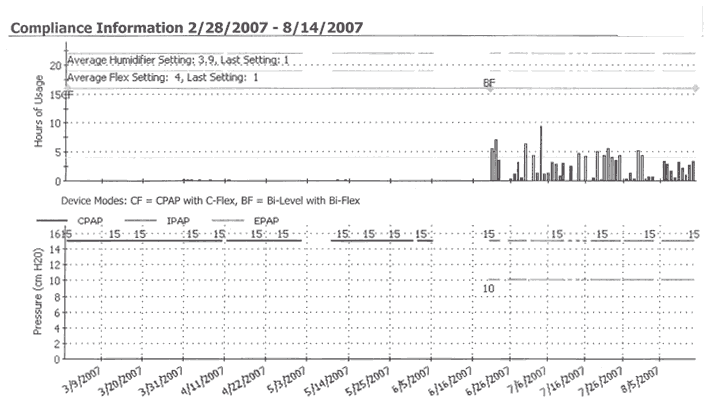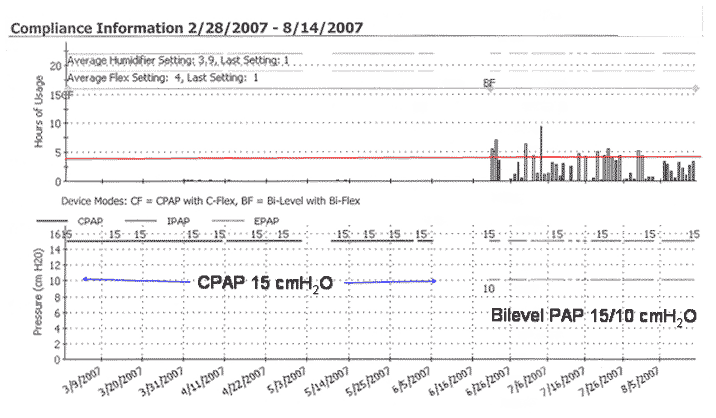Contributed by James A. Rowley, MD
A 47 year old male returns to the Sleep Disorders Clinic for follow-up. Initial PSG showed severe obstructive sleep apnea with an AHI 156. Based upon a continuous positive airway pressure (CPAP) titration study, the patient was prescribed CPAP at 15 cmH2O. The patient was subsequently titrated on bi-level PAP at IPAP 15 cmH2O and EPAP 10 cmH2O. The compliance report is summarized graphically in the figure. How would you characterize the overall compliance of this patient?
The compliance report shown is for a 5½ month period. The top portion of the compliance report shows day-to-day usage. Between 2/28/2007 and 6/21/2007 the patient essentially did not use his CPAP (set at 15 cmH2O, see bottom portion of graph). The patient attempted to use the CPAP daily but never achieved >30 minutes of use (because of scaling, this cannot be seen on the report). Starting 6/21/2007, the patient was treated with bi-level PAP. Daily usage became more common, though on the majority of nights he still was not using the PAP for >4 hours (as indicated by the red line on the graph).
In the 2006 practice parameters for the use of CPAP and bi-level PAP, parameter 4.5.1 states bi-level PAP ‘is an optional therapy in some cases where high pressure is needed and the patient experiences difficulty exhaling against a fixed pressure …’. This parameter was labeled as a ‘guideline’, indicating that it is patient care strategy with a moderate degree of certainty. This guideline was based upon clinical experience as two studies have found no difference in efficacy and compliance between CPAP and bi-level PAP in previously untreated patients.
For this patient, the use bi-level PAP resulted in improved compliance, though the use does not meet an accepted definition of good compliance, which is generally use >4 hours per night for more than 5 nights per week. In this particular case, the patient also had an erratic sleep schedule; sleep and sleep hygiene education was provided to the patient as the next intervention to improve his compliance.
References
Kushida CA, et al. Practice parameters for the use of continuous positive airway pressure and bilevel positive airway pressure devices to treat adult patients with sleep-related breathing disorders. Sleep 2006; 29:375-380.
Gay PC, et al. A randomized, double-blind clinical trial comparing continuous positive airway pressure with a novel bilevel system for treatment of obstructive sleep apnea syndrome. Sleep 2003; 26:864-869.
Reeves-Hoche MK, et al. Continuous versus bilevel positive airway pressure for obstructive sleep apnea. Am J Respir Crit Care Med 1995; 151:443-449.
Engleman HM, Wild MR. Improving CPAP use by patients with the sleep apnea/hypopnea syndrome (SAHS). Sleep Med Rev 2002; 7:81-99.
Kakkar RK and Berry RB. 2007. Positive airway pressure treatment for obstructive sleep apnea. Chest 132:1057-1072.





